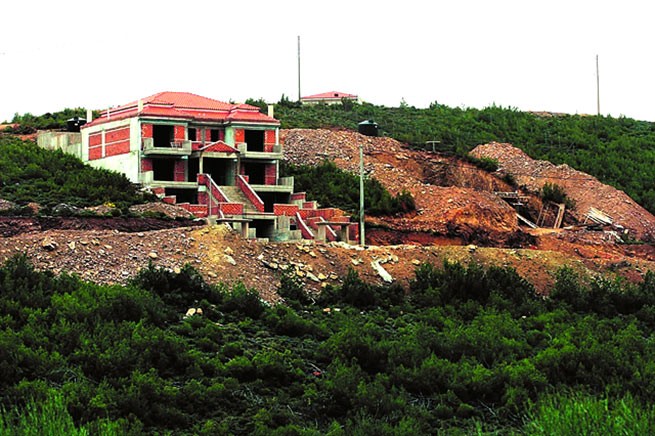A legislative decree of the Ministry of the Environment unfreezes the purchase and sale of real estate built outside the development plan (εκτός σχεδίου).
The legislation is expected to be included in one of the Ministry of Environment’s bills to be submitted to parliament before the end of the year. The law provides for the introduction of a special fee in favor of the Green Fund, which will act as an environmental equivalent.
It is clarified that the legislative regulation will not be final, but transitional and will cover the period until December 31, 2025, when, according to estimates, the designation of public roads in the country will be completed.
It is noted that the bill was supposed to be adopted before the close of parliament for elections, but was “frozen” in an attempt to avoid a conflict with the recent decision of the State Council. After appealing a building permit on a plot of land in an unplanned area on Patmos, without access to a recognized public road, the State Council ruled that the minimum area of 40 acres was not sufficient, but that construction on the site had required a public road since 1985.
Details of the new regulatory act
TA NEA has provided details of the expected new law, which makes it possible to develop legal land (sites) of at least four acres in area, outside the plans or boundaries of legally existing settlements, if they fall into one of the following categories of land (sites), depending from the time of creation and appearance of the street:
A) Sites created between May 31, 1985 and December 31, 2003.
To be built on, they must have one of their boundaries adjacent to the street for at least 3.5 meters: (1) appear on aerial photographs prior to July 27, 1977, and be at least 3.5 meters wide; (2) connects to an international, provincial, municipal or community road or abandoned portion thereof; (3) is open by decision of a public authority or is registered in the land registry, or is paved by an authority or organization responsible for the maintenance and improvement of roads, or has a public utility network running through it.
B) Land plots created before 1985.
In order for these sites to be suitable for construction, they must front or be adjacent to a road at least 3.5 meters long on a road that 1) appeared on aerial photographs before July 27, 1977, 2) has a width of at least 3.5 meters, 3) was opened by decision of a government authority, or registered as an “EC” (special zone), or paved by an authority responsible for the maintenance and improvement of roads, or utility networks pass through it.
B) Lands on which construction can be built include those that have a legal roadway of at least 3.5 meters in width, built before 1985, which is connected to an international, provincial, municipal or community road or abandoned sections thereof.
A big problem is the so-called “blind” areas, that is, those that are not connected to the road network. In this case, if before 1985 there was no legal way to connect them to public roads that meet the above requirements, you cannot build on them.
As mentioned above, legislative regulation is not final, but transitional and will cover the period until December 31, 2025, that is, until the definition of public roads is completed.
The question logically arises: what will be applied from 2026? According to sources familiar with the matter, after the expiration of the transitional provision, land plots located in unplanned areas and not connected to a recognized public road will regain the right to build, depending on the circumstances, when the registration process for the public road network is completed use in the relevant local urban plan of the territory.
The risk of new unauthorized buildings
“From the point of view of urban planning, unplanned development is not arbitrary, but with strict rules and a very low building coefficient, which does not harm the environment, and its abolition risks leading us to a new generation of arbitrary buildings.”– the president emphasizes POMIDA Stratos Paradias in an interview with NEA. – “That is why the Ministry of the Environment must give this issue not just a transitional, but a final solution that will protect citizens’ property and not devalue it.”
What’s been happening all these years
For all plots of land over 4,000 square meters (40 acres), and in some areas over 8,000 or 20,000 square meters, if they were created before 2003, even if they did not front a road but had protected access, planning authorities issued (some still issue) planning permission. This is because there is ambiguity in planning law as to when the requirement for a public road on off-plan properties arises and what exactly is meant by a public road.
However, the 2003 law (3212/2003) for the first time introduced the obligation to create, from 12/31/2003, plots of land suitable for construction, with a minimum area of 40 acres and a minimum access to a public road of 25 meters in length, which was not in the 1985 law years, nor in the earlier laws of 1978 and 1928.
PS For those who do not understand the importance of this law, I can inform you that this decision will throw a wrench into the real estate market hundreds of thousands of land plots (more than 800 thousand), as well as hundreds of thousands of real estate objects (about 400 thousand), often in very good places that previously could not be sold officially.







More Stories
Fruits and vegetables: imports up 50.2% in April
Greek products on their way to France
Reduced fees for POS transactions, limited bank fees